Posters
Another form of participation of our organization in the congresses of marine mammals is through the publication of posters with information about our work
ETHOGRAM OF HUMPBACK WHALE IN BANDERAS BAY MEXICO .XXV International Reunion For The Study Of Sea Mammals La Paz, BCS del 7 al 11 de May 2000.

The humpback whale (Megaptera novaengliae) is known as the most exhibitionist of all the whales. The cartel shows a photographic work of 10 years which ilustrates each different behavior on surface observed in Banderas Bay such as some recording songs in the area..
BOTTLENOSE DOLPHIN ( Tursiops truncatus) NI BANDERAS BAY, MEXICO.XXV International Reunion For The Study Of Sea Mammals. La Paz, BCS del 7 al 11 May 2000.

Preliminary results from the studues conducted with a resident bottlenose group (Tursiops truncatus) in Banderas Bay are presented. The monitoring has been done since august 1998 so far. During this period 60 individuals haven been photoidentified, and the recapture of individuals took us the conclusion of the residency of this group and the occasional presence of individuals belonging to other groups. The behavior they exibit has been identified and documented such as the different whistles they make during this activities, allowing us to set up the distribution and use os habitat of this group. Finally particular relationship between individuals have benn establish even though long-term studies are necessary to know more about their social structure.( Instead of a poster is precent for the first time in the SOMEMA an interactive computer )
Observation of a gray whale ( Eschrictius robustus ) and two breed. XXVII International Reunion For The Study Of Sea Mammals. Veracruz, Ver. May 12 – 15 2002.
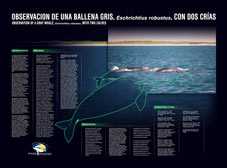
The gray whale is a migratory species with a seasonal reproduction. Between january and march the population is located in its winter distribution area which goes from the middle of California state down to the extreme south of Baja California. Some of the members occasionally enter the Gulf of California.
Most of the activities related with their reproduction occurs in the coast lagoons of Baja California Sur: Ojo de Liebre, Sn. Ignacio and the lagoons complex of Magadalena´s Bay. It is in here where the 85% of the breed are born every season. According to the records, female produce one brood and the relationship between the whale mother and its baby is very close but only during 7 or 9 months until the weaning occurs.
Multiple delivery in sea mammals is extremely rare and it does not exist any information about this among cetaceans.
However in February 22nd, 2002 – while we were in a tour at the north of Magdalenas´ Bay , very close to La Boca de la Soledad – we saw in several times to a very large whale with two broods by each side. Both babies were swimming very close to the mother for about an hour until they went away.
In the area, there were several other whales with their babies. We counted about a hundred whales and most of them were found near La Boca de la Soledad. Pictures were presented and we had a discussion about this unsusual situation.
DIGITAL CATALOG OF THE HUMPBACK WHALE (Megaptera novaengliae), IN BANDERAS BAY, FROM 1991 TO 2003. XXVIII International Reunion For The Study Of Sea Mammals. Nuevo Vallarta, May 12th – 14th, 2003.
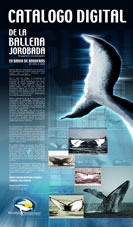
During years, researchers have used the photoidentification of the ventral fluke of the humpback whale to identify them individually. With passage of time, the increase of photographic information as well as the need of new methodologies to be able to compare the new photographs with the existing ones. On this work its presented a digital catalog and data base containing information taken on the area of Banderas Bay from 1991 to 2003. This catalog has around 400 different flukes of humpback whales photographed (digitalized) in the area during this period. For the clasification of the flukes it is used a combination of methodology using the 5 categories according to the pattern of pigmentation from white to black, as well as the 38 stylised patterns that symbolized the variation of pigmentation, and the 14 sector map in the fluke. This catalog is made on file maker pro, on which putting on specific fields the different variables and information of each fluke helps the fast localization of a fluke to consult, moreover this program has the advantage to be compatible with PC and Mac platforms.
Wound and Amputations Observed in a Humpeack Whale ( Megaptera novaengliae) in Banderas´ Bay. XXVIII International Reunion For The Studies Of Sea Mammals. Nuevo Vallarta May 12th – 14th , 2003.
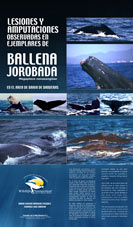
Humpeack whales, as any other cetaceans, are exposed to be hurt by fishing tackles, predators or human activities when people use propels, harpoons or ship keels. In the area of Banderas´ Bay we have witnessed since 1996 several humpeack whales with different wounds and amputations. Among these injuries we have found wounds on the tail fin, amputation of half tail fin, severe damage on its back , besides the extraordinary case that took place during December 2002 when a whale without its tail fin was observed.
In this work it is presented in photos and video several different types of wounds and amputations observed in some bumped whales in Banderas´ Bay including that unusual case of the whale without a tail fin.
INCIDENCE OF THE DIFFERENT CETACEANS AND THEIR RESPECTIVE PHOTOIDENTIFICATION CATALOGUES FOR THE AREA OF BANDERAS.
1 INTERNATIONAL REUNION FOR THE STUDIES OF SEA MAMMALS SOMEMMA – SOLAMAC
MERIDA YUCATAN MAY 5- 9 NOVEMBER 2006
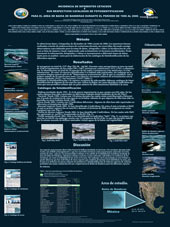
Banderas Bay area is distinguished for the diversity of cetacean that can be observed throughout the whole year. Since December 1996 observations have been conducted from an ecotourism vessel dedicated to cetacean observation, in which there has been registered and photoidentified the different species observed during these tours. This has not only allowed the intense monitoring of the most common species such as the humpback whale (Megaptera novaeangliae) and the bottlenose dolphins (Tursiops truncatus) but also there has been possible the continuous record of spotted dolphin (Stenella atenuatta), spinner dolphin (Stenella longirostris), rouge toothed dolphin (Steno bredanensis), killer whales (Orcinus orca), false killer whale (Pseudorca crassidens), bryde whales (Balaenoptera edeni), gray whale (Eschrichtius robustus) as well as the first report of minke whale (Balaenoptera acuturostrata) in the zone which helps to increase to one more species to the list of species observed inside Banderas Bay waters. Likewise as for humpback whales and bottlenose dolphins, there has been done photoidentification of the different species observed, which has brought as result catalogues of photoidentification for the different observed species, as well as the estimation of certain loyalty of some individuals of these different species to Banderas Bay area.
KILLER WHALE RAKE MARKS SCARRING OBSERVED ON HUMPBACKWHALE FLUKES IN THE DIGITAL PHOTOIDENTIFICATION CATALOGUE OF BANDERAS BAY. 1 INTERNATIONAL REUNION FOR THE STUDIES OF SEA MAMMALS SOMEMMA – SOLAMAC MERIDA YUCATAN MAY 5- 9 NOVEMBER 2006
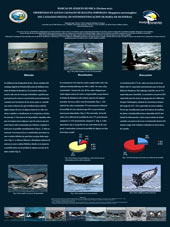
The killer whales (Orcinus orca) are widely distributed on all the North Pacific. They are considered to be the principal predator of cetacean including the humpback whale (Megaptera novaeangliae). Even though killer whales are very persuasive predators not all their assaults are mortal nevertheless they manage to leave linear marks and parallel bars caused by their teeth while they bite their preys. In the case of the humpback whales the evidence of these attacks can be detected when this type of marks are observed on their flukes. The photoidentification catalogue of Banderas Bay was used to identify individuals with rake scarring, it was calculated that 10% of the flukes catalogued present these type of marks, in where there can be observed that these marks varies from slight and moderate, deeper scars even to the partial or almost total lost of one or both fluke lobes. This marks allows to identify the individual easier due they last through the years, likewise it suggests that these assaults did not affected their survival since individuals who presented these marks have been re-captured during several seasons.